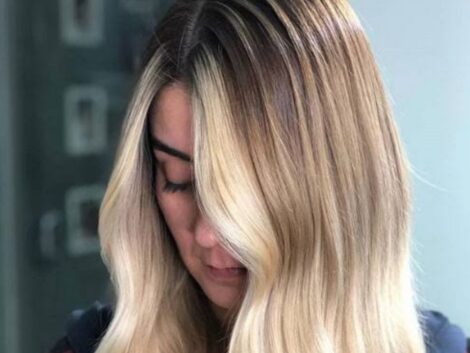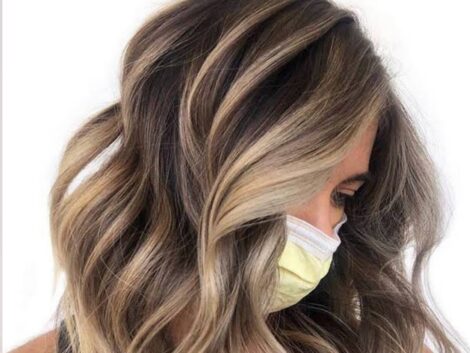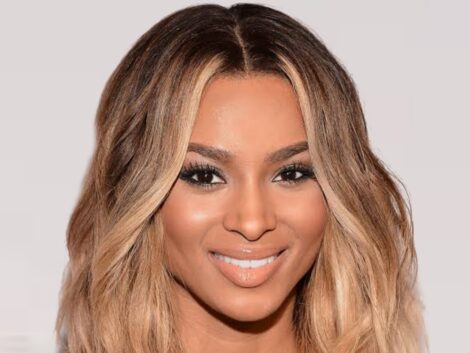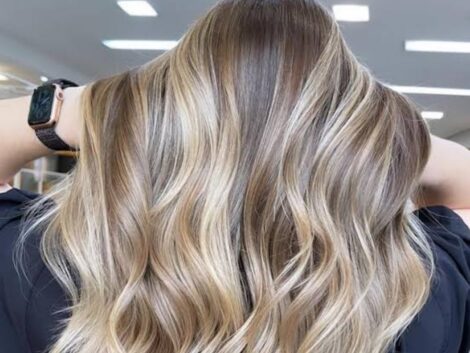The term “balayage” comes from the French word meaning “to sweep” or “to paint,” which accurately describes the method used in balayage highlights. It is a hair coloring technique that creates natural-looking, sun-kissed highlights.
Where traditional highlighting techniques use foils or caps, balayage involves hand-painting the color onto the hair. Here the stylist strategically places the highlights in a sweeping motion, typically starting from the mid-lengths of the hair towards the ends. The final outcome is- a soft, blended effect that mimics the natural way hair lightens from sun exposure.
The most prominent characteristic of balayage highlights is the seamless transition between the base color and the highlighted sections. In this method, the colorist can customize the placement and intensity of the highlights to complement the client’s hair color, skin tone, and desired look. Balayage is often associated with softer, more natural-looking results compared to traditional highlights.
Another good thing is balayage can be done on any hair length or texture, from short pixie cuts to long flowing locks. It is a versatile technique that can be used to achieve various effects, from subtle dimensions to more dramatic contrasts. Also, the maintenance for balayage is generally low, as the regrowth is not as noticeable compared to traditional highlights, making it a popular choice for those seeking a low-maintenance color option.
It’s wise to consult with a professional colorist as they can help determine the most flattering placement and color choices based on individual preferences and hair characteristics.
How long does balayage last?
The duration of a balayage hairstyle can vary depending on various factors, such as your hair’s natural color, the desired result, your hair’s texture and porosity, and how well you take care of your hair. However, on average, balayage can last between 8 to 12 weeks before it starts to fade or grow out.
Balayage is a unique highlighting technique where the color is hand-painted onto the hair, creating a soft, natural-looking effect. Unlike traditional foil highlights, which start from the root, balayage focuses on the mid-lengths and ends of the hair. As a result, the regrowth is less noticeable, and the color transition is more seamless.
Since balayage is a low-maintenance technique, it requires less frequent touch-ups than other coloring methods. The gradual fading and soft growth-out make it a popular choice for individuals who prefer a more natural look or those who don’t want to visit the salon frequently for touch-ups.
To prolong the lifespan of your balayage, it is important to use color-safe shampoos and conditioners, minimize exposure to excessive heat styling, and protect your hair from the sun and chlorine. Regularly using color-enhancing products or scheduling glossing treatments can also help refresh and revive the color between salon visits.
It’s worth noting that these timeframes are approximate, and the longevity of balayage can vary from person to person. Suppose you have any specific concerns or questions about your balayage. In that case, it’s best to consult with a professional hairstylist who can provide personalized advice based on your hair type and color.

Is balayage better than highlights?
Whether balayage or highlights are better depends on individual preferences and desired results. Both techniques offer different effects and benefits.
It is a hair coloring technique that evolved from France that involves painting highlights on hair using hands. It creates a more natural, sun-kissed look as the color is seamlessly blended into the hair, as it is done by using swiping motion. Balayage allows for a softer grow-out and requires less maintenance since the highlights are not placed all the way to the roots. This technique offers versatility in terms of color placement and can be customized to suit different hair types and lengths.
On the other hand, traditional foil highlights involve sectioning the hair and applying color to specific strands using foils. This technique provides a more defined and precise look with lighter, more uniform highlights. Foil highlights can be applied closer to the roots, resulting in a more noticeable contrast between the colored and natural hair.
Ultimately, the choice between balayage and highlights depends on personal style, hair type, and desired outcome. It’s a good idea to consult with a professional hairstylist who can assess your hair and help you determine which technique will best achieve your desired look.
What is the difference between a balayage and highlights?
Balayage and highlights are both popular hair coloring techniques, but they differ in terms of application and overall effect. How these two differ from each other is discussed briefly below:
Technique
Balayage involves the hand-painting or freehand application of color onto the hair. The color is swept onto the hair surface in a sweeping motion, creating a soft, natural-looking gradient effect. On the other hand, highlights typically involve sectioning the hair and applying color using foils or caps, resulting in more defined, uniform streaks of color.
Placement
Balayage focuses on creating a sun-kissed, natural appearance. The color is strategically placed on the hair in a way that mimics the natural patterns of light and shadow. Highlights, on the other hand, can be placed throughout the hair more uniformly or in a pattern, often starting closer to the roots and extending to the ends.
Result
Balayage generally results in a more subtle and blended effect. The color seamlessly blends with the natural hair color, creating a soft, low-maintenance look with less noticeable regrowth. Highlights, especially if placed closer to the roots, can create a more contrasting effect and may require more frequent touch-ups as the hair grows out.
Maintenance
Balayage is known for its low-maintenance nature. Because the color is applied in a less structured way, there is less noticeable regrowth, and touch-ups are typically needed less frequently. Highlights, particularly if they start at the roots, may require more frequent maintenance to cover visible regrowth.
Versatility
Balayage is versatile and can be tailored to suit various hair colors, lengths, and textures. It works well with both dark and light hair and can be adapted for a subtle or bold look. Highlights can also be versatile but may require more careful color selection and placement to achieve the desired effect, especially on darker hair.
It’s worth noting that the final result of both balayage and highlights will depend on factors such as the client’s natural hair color, desired look, and the skill of the stylist. It’s always recommended to consult with a professional hairstylist to determine the best technique and approach for your hair.
Is balayage more expensive than highlights?
The cost of balayage versus highlights can vary depending on various factors, such as the salon’s location, the stylist’s expertise, and the specific services included in each treatment. However, in general, balayage tends to be more expensive than traditional highlights.
This hair coloring technique is done using hands and gives a more blended and sun-kissed look. It typically requires more skill and time from the stylist, as they need to carefully apply the color freely. This extra time and expertise involved in the balayage process often contribute to the higher cost.
On the other hand, traditional highlights usually involve using foils or caps to isolate sections of hair for color application. While this technique can still require precision and skill, it is generally quicker than balayage.
It’s important to note that pricing can vary significantly between salons and stylists, so it’s always a good idea to consult with your preferred salon or stylist to get an accurate cost estimate for the specific services you’re considering.
Why is balayage so expensive?
Balayage, a hair coloring technique that creates natural-looking highlights, can often be more expensive compared to traditional highlighting methods for several reasons:
- Skill and Expertise: Balayage requires a high level of skill and expertise from the hairstylist. It involves freehand painting of color onto the hair, which requires precision and a deep understanding of color theory. Experienced stylists who specialize in balayage often charge higher prices due to their expertise.
- Time and Effort: Balayage is a meticulous and time-consuming process. It involves sectioning the hair, carefully applying the color, and monitoring the development to achieve the desired results. This process can take longer than traditional highlighting methods, which can contribute to the higher cost.
- Customization: Balayage is known for its customized and personalized approach. The color is applied strategically to create a natural and blended effect that complements the individual’s hair color, texture, and facial features. This level of customization requires additional time and attention, leading to a higher price point.
- Product Usage: Balayage often requires the use of high-quality professional products to achieve optimal results. These products can be more expensive than standard hair coloring products, contributing to the overall cost.
- Demand and Trendiness: Balayage has gained immense popularity recently and has become a highly sought-after hair coloring technique. The increased demand for balayage has also influenced its pricing, as salons can charge higher prices for a service in high demand.
It’s important to note that the pricing of balayage can vary depending on the salon, location, stylist’s experience, and other factors. It’s always recommended to consult with a salon or hairstylist directly to understand the pricing structure for balayage in your area.
Lastly, check out the mane caper shop.




